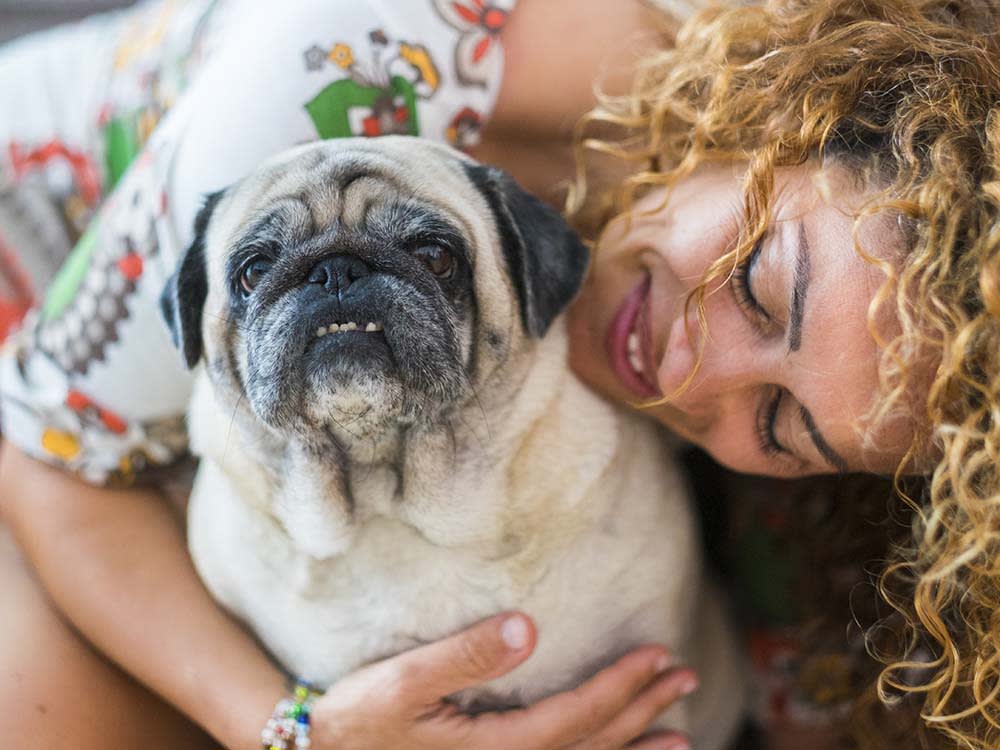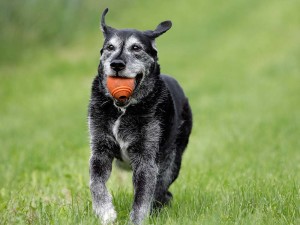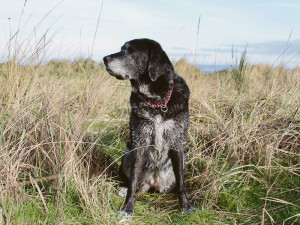How to Care For Your Older Dog
Learn how to make their senior years as comfortable as possible.

share article
Your dog can't hear you call their name; their back legs are stiff; they’ve developed a fear of thunderstorms they once slept through; their muzzle long ago turned gray. As time goes by, these signs of aging become more dramatic, and the nighttime wandering, disorientationopens in a new tab, difficulty with stairs, and indoor accidents begin.
At this point, your dog is entering a twilight time. You can see the horizon — a last illness or last visit to the vet — but you’re not ready to give up. With a little effort, you can provide your senior dog the care and comfort they need during the last bit of time you share.
Recently, we nursed our smallish, mixed-breed dog, Shucks, through his last illness — near the end of his almost 16-year life. Given his age, we made more frequent visits to our veterinarian, Dr. Arthur Wohlfeiler, and we made it through thanks to his moral support, as well some great tips and helpful products from Dr. Nicholas Dodman’s book, Good Old Dog: Expert Advice for Keeping Your Aging Dog Happy, Healthy, and Comfortableopens in a new tab. Here's what we learned.
How to Nourish a Senior Dog
Keep them hydrated.
If your old dog loses track of their water dish or is physically unable to get to it, it’s up to you to make sure they drink. Bring the water to them. You may have to hold the dish in front of them and wet their mouth so they get the idea. You can also make the water more interesting by dissolving sodium-free chicken bouillon in it, Dr. Dodman suggests. Both the aroma and the flavor will encourage drinking. Adding a half-cup or so of water to food (both dry and canned) will help hydrate them as well — they won’t mind the soupiness.
Adjust feeding as needed.
As with people, dogs’ dietary needs and preferences usually change as they age. If that’s the case for your dog, try adjusting their feeding schedule. Reluctant eaters can often be tempted by small portions throughout the day. Continue to feed their regular food as long as they like it. Switching from dry food to canned, however, may help a dog whose teeth are worn or damaged, and its stronger smell may encourage appetite.
Make food enticing.
Although your dog’s sight and hearing may decline, their sense of smell won’t. If they can smell dinner, they’re more likely to gobble it. So, warm the food slightly in the microwave and add bouillon or some other flavorful treat to pique interest. Don’t automatically switch to a “senior dog” diet, either. The term is really unregulated, and, depending on an individual dog’s specific health issues, some of those formulations can compromise their health. (Be sure to talk to your vet about any dietary changes you’re considering.)
You can also encourage eating by feeding from one of your own dinner plates. For whatever reason, food from a “human” plate is sometimes more appealing than food from a dog bowl. While you’re eating, keep their plate on the table next to yours, and as soon as you’re finished, give your dog dinner.
Elevate the food bowl.
Some dogs find it difficult to lower their head to their bowl. Raising the bowl in an elevated feeder or even on a low bench helps.
Try a dog buffet.
In a casserole-type dish, arrange an assortment of foods in small piles and let your dog graze. After they’ve eaten the things that strike their fancy, combine the leftovers in a small ball or two and hand-feed it, if necessary.
Most importantly, remember not to force the issue of feeding. A lack of interest in food and water is, of course, a sign your dog is near the end. Respect the message they’re sending.
How to Help a Senior Dog Get Around
Go on brief walks.
Don’t stop taking your dog for walks just because they’re old and slow. Dogs need the exercise, mental stimulation, and sense of belonging that walks give them. Just make sure you don’t overdo it. In warm weather, stop when they slow down, and in cold weather, dress them in suitable outdoor garments — a snug sweater or coat. Revise your definition of a walk. Sometimes, a slow turn down the driveway can be a perfectly good outing.
Make DIY traction pads.
Improve traction by tacking a piece of outdoor carpet to slippery stairs and using non-slip rugs inside. If you have a neglected yoga mat rolled up in your closet, it can also be used both inside and out as a traction aid — it’s easy to cut to size if you don’t need the entire length or width.
Rearrange the house for optimal mobility.
Move your furniture, as much as you’re able, to facilitate your dog’s movement around your home. Keep debris off the floor, as even a stray magazine or slipper can trip up an arthritic dog. Block areas where they might get stuck.
Buy a ramp or stairs.
Steps and ramps made especially for dogs are available online and in pet stores. Be aware, however, that many older dogs are reluctant to change their habits, and high steps and ramps might scare them. Never force their use.
Take advantage of towels.
You can use them to wrap your smaller dog up when you carry him outside. Or, if your dog is big with mobility issues, you can use a large towel as a sling. (Dog slings are also available online and at pet stores.)
How to Keep a Senior Dog Clean
Rinse and repeat.
During our dog’s last summer, we kept a plastic storage bin filled with water in our yard. The sun warmed the water, and it was always there to rinse him off if he soiled himself. That being said, keep in mind that your old dog is susceptible to changes in temperature. If you get them wet, dry and warm them as quickly as possible.
Rags, rags, and more rags.
Keep rags handy at all times and check out your local pet store for special drying towels. Your elderly dog can’t shake off the water like he used to and these thirsty towels are a great help.
Diaper up if needed.
Believe it or not, there are such things as doggie diapers, and you might want to try them. Other products intended for housebreaking puppies can also help with your elderly dog. For example, pee pads provide a comfortable bed if they’re having accidents in their sleep. Washable waterproof pads (often carried at medical supply stores and children’s bedding outlets) are also good for this use — just get several so you always have one or two clean. Odor removers will help keep your house livable.
Although it’s often emotionally draining, caring for senior dogs can also be a gift. It’s an opportunity for you to reach a consensus on hard final decisions, and to share your feelings about the approaching loss. Even more importantly, the experience gives you one last chance to show the best dog in the world just how much they mean to you.
Kathy Ewing
Kathy Ewing has lived in Cleveland Heights, Ohio, for thirty-six years. Her writing has been published widely in the Cleveland Plain Dealer, The Millions, Cleveland Magazine, The Bark among others.
Related articles
![Older dog playing with ball in a green field]() opens in a new tab
opens in a new tabDog Arthritis Treatment: How to Relieve Arthritis Pain in Dogs
Tips for treating achy joints — from medications to massages.
![Portrait Of Large, Senior, Mixed Breed Dog On Beach]() opens in a new tab
opens in a new tabHow to Grieve a Pet
For National Pet Memorial Day — Sept. 12th — we asked 5 grief experts how to cope with feelings of guilt after we lose a pet.

